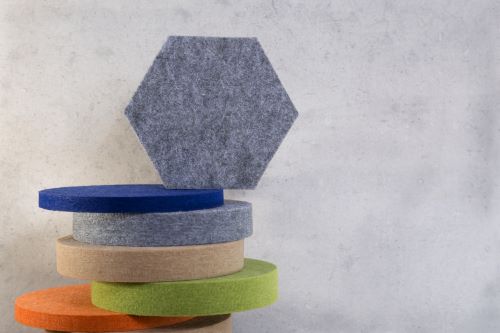When you think of acoustical absorption panels, you may picture the standard 2’x4′ that you’d see in recording studios, restaurants or churches. Yet, acoustic wall panels are actually available in a number of shapes, sizes, and materials. They can be customized to fit any space while blending into its surrounding environment, or standing out as a decorative touch. The most common acoustic absorption panels are typically made from a 6 pcf fiberglass, but other materials can include recycled polyester, cementitious wood fiber, and perforated wood.
Prefabricated Panels vs Field Fabricated Acoustic Panels
Prefabricated acoustical panels are made using a core, either 1″ or 2″ in thickness, and are wrapped in acoustically transparent fabric. Fiberglass cores are most commonly 6-7 pcf, but can sometimes be 3 pcf. In terms of acoustics, they have similar performance but 6 pcf cores can be hardened with a layer of impact resistance added to the face (which is a 16 PCF 1/8″ thick layer).
The most popular brand of acoustic fabric is Guilford of Maine, but other brands include Designtex, Maharam, and Wolf Gordon. With an abundance of fabric color options, it can be enjoyable for some when designing the panels they need. There are even special acoustic fabrics that can be printed on through a process called dye-sublimation, so that acoustic panels can be art-wrapped.

Although prefabricated panels aren’t meant to be modified in the field, they can be if needed. This would required unwrapping the panel, cutting the edge using a table saw and then re-adhering the fabric to the panel. Prefabricated panels are generally fastened to the wall using impaling clips or z-clips.
Field fabricated acoustic panels, commonly known as stretched fabric wall, is a stretch fabric system that’s essentially identical to fiberglass panels, except that it may be built around obstructions or penetrations in the field. This is most appropriate when panels are extended from floor to ceiling, wall to wall, or numerous penetrations occur on the partition.
Ceiling Clouds, Baffles and Direct Mounts
Acoustic ceiling panels are always prefabricated, but they can be hung in a few different ways:
- Ceiling clouds
- Ceiling baffles
- Direct mount ceiling panels
Acoustic ceiling clouds are generally constructed using the 2″ thick core, and wrapped in acoustically transparent fabric. They hang down from the ceiling horizontally, attached by anchors that are screwed into the back of the panel with a metal eyelet attached to the ceiling. The cloud-style mounting method allows more surface area of the panel to be available for more sound absorption. It’s also a necessary mounting method for corrugated metal ceilings, since you can’t do a direct-mount on those.
Acoustic ceiling baffles are similar to ceiling clouds in how the surface area absorbs sound, but they hang vertically. This mounting method is mainly for spaces with high ceilings such as office lobbies, gymnasiums, and restaurants. Baffles are hung from the ceiling using airline wire that attaches to metal brackets along the top edge of the panel.
Direct ceiling mounted panels are directly attached to the ceiling using anchors screwed in flush to the back of the panel. The other part of the anchor is attached to the ceiling, and the panel can be snapped into place. Direct mounts are usually used in spaces with flat gypsum or concrete ceilings, allowing for the panels to blend into a space better.
Specialty Sound Absorbing Materials

Other specialty sound absorbing panels and materials are typically more decorative than functional, like PET and felt panels for example.
PET (or recycled polyester) and felt acoustic panels are more decorative, only appropriate for use in small conference rooms, team rooms or phone rooms. They’re typically available in 1/2″ and 1″ thicknesses with low NRC ratings. There’s no need to wrap PET panels in acoustically transparent fabric because the polyester is already dyed to the desired color.
Felt and PET panels are normally field cut with a razor blade or circular saw and then fastened to the wall with construction adhesive.
Cementitious wood fiber panels, such as tectum are heavy-duty, preferable for high impact areas. Tectum type panels are usually cut in the field using a table saw, hung, and then painted. They usually require a type e mount with airspace behind it, filled with fiberglass insulation. The hardness of cementitious panels competes with the impact resistance versions of the fiberglass acoustical panels.
Types of Acoustical Absorption Panels – Conclusion
Let’s review the acoustical absorption panel types listed in this article:
- Prefabricated
- Field fabricated like stretched fabric wall
- Ceiling clouds/baffles
- PET/felt panels
- Tectum
The type of acoustic panel you choose will vary greatly based on the desired material, price, size, shape, color, benefits, etc. Luckily for you, our team is here to help with any questions relating to panels or assistance in purchasing our custom-made panels!





